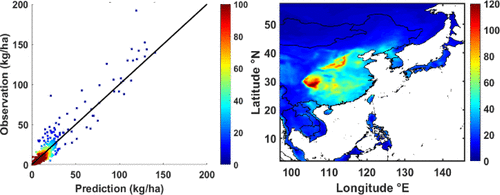当前位置:
X-MOL 学术
›
Environ. Sci. Technol.
›
论文详情
Our official English website, www.x-mol.net, welcomes your
feedback! (Note: you will need to create a separate account there.)
Estimations of Long-Term nss-SO42- and NO3- Wet Depositions over East Asia by Use of Ensemble Machine-Learning Method.
Environmental Science & Technology ( IF 10.8 ) Pub Date : 2020-08-18 , DOI: 10.1021/acs.est.0c01068 Xingcheng Lu 1 , Dehao Yuan 2 , Yiang Chen 1 , Jimmy C H Fung 1, 2 , Wenkai Li 3 , Alexis K H Lau 1
Environmental Science & Technology ( IF 10.8 ) Pub Date : 2020-08-18 , DOI: 10.1021/acs.est.0c01068 Xingcheng Lu 1 , Dehao Yuan 2 , Yiang Chen 1 , Jimmy C H Fung 1, 2 , Wenkai Li 3 , Alexis K H Lau 1
Affiliation

|
Wet deposition of non-sea-salt sulfate (nss-SO42–) and nitrate (NO3–), derived from anthropogenic emissions of SO2 and NOx, exerts adverse effects on ecosystems. In this work, an ensemble back-propagation neural network was proposed to estimate the long-term wet depositions of nss-SO42– (2005–2017) and NO3– (2001–2014) over East Asia in 10 km resolution. The R2 values for the 10-fold cross-validation of annual wet depositions of nss-SO42– and NO3– were 0.90 and 0.85, respectively. The hotspots of the wet deposition of these two acidic species span southwestern, central, and eastern China. The molar ratio of NO3– to nss-SO42– increased in 10 out of 12 analyzed East Asian countries from 2005 to 2014, which indicates that the acidity in rainwater shifts from the sulfur type to nitrogen type over most of the regions. The wet deposition on the four ecosystems (forest, grassland, cropland, and freshwater body) was also analyzed. Results showed that the nss-SO42– wet deposition on 25.5% of freshwater bodies in 2015 and NO3– wet deposition on 21.7% of grassland in 2014 exceeded the ecosystem empirical critical loads (25 kg/ha sulfate and 2 kg N/ha) in East Asia. Thus, more stringent and regionally collaborative sulfur and nitrogen emission-control measures are urgently needed to protect the ecosystem of East Asia.
更新日期:2020-09-15











































 京公网安备 11010802027423号
京公网安备 11010802027423号